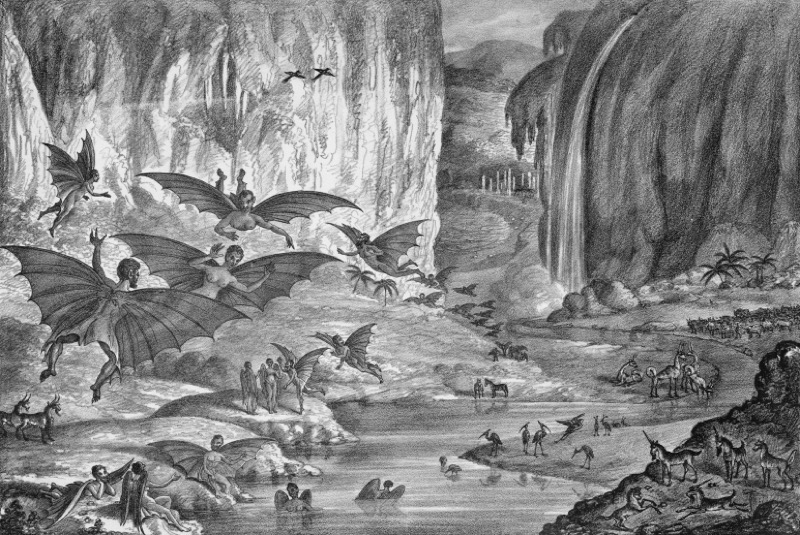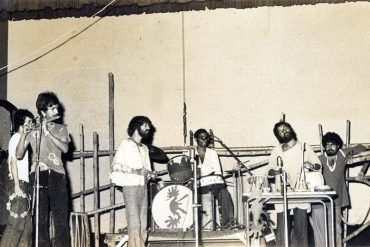In 1835, the pages of the New York Sun unfolded the most mind-boggling astronomical discovery. It was also one of the greatest hoaxes of the time!
Describing the findings of Sir John Herschel, a well-known English astronomer, the newspaper reported that there was life on the moon. The report said there were sightings of unicorns, humans with bat-like wings, and two-legged beavers.
In reality, Herschel went to Capetown, South Africa, in January 1834 to establish an observatory with a powerful new telescope. Put together by the editor of The New York Sun, Richard Adams Locke, the series of articles gave a detailed description of Herschel’s discovery.
Locke wrote about the evidence of living beings on the moon. He provided details of the landscape, replete with huge craters, giant amethyst crystals, flowing rivers, and luxuriant flora.
In the first of the series of articles published on 25 August, Locke narrated Herschel’s story of creating a massive telescope lens, 24 feet in diameter and 7 tonnes in weight. Herschel’s lens was six times bigger than the largest lens. He carted it from England to South Africa. He then wrote about Herschel’s fantastical discoveries that would initiate the biggest hoax of all time.
“By means of a telescope of vast dimensions and an entirely new principle,” he wrote, “the younger Herschel… has already made the most extraordinary discoveries in every planet of our solar system; has discovered planets in other solar systems; has obtained a distinct view of objects in the moon, fully equal to that which the naked eye commands of terrestrial objects at the distance of a hundred yards.” He continued, “[Herschel] has affirmatively settled the question whether this satellite be inhabited, and by what order of things; has firmly established a new theory of cometary phenomena; and has solved or corrected nearly every leading problem of mathematical astronomy.”
The New York Sun published a detailed description of the discoveries on the moon over six days with the astronomer’s massive telescope. Locke reported vegetation on the moon, white sand beaches, pyramids, and rivers. He introduced mythical creatures such as the moon bison, blue-coloured goats with a single horn, flying humans, and many more.
“We scientifically denominated them as Vespertilio-homo, or man-bat; and they are doubtless innocent and happy creatures,” reported the journalist of the New York Sun.
The nineteenth century was a period of exploration, “the time before we knew everything,” explained Kirsten van der Veen of the Smithsonian Institution’s Dibner Library of the History of Science and Technology.
“Science was extremely approachable,” claims van der Veen. People read about scientific discoveries and voyages to distant lands in the pages of newspapers, journals, and books during that time. They believed anything and everything. The Herschel story was not out of the ordinary in the daily publication. Additionally, the articles were reprinted from the Edinburgh Journal of Science, which gave it credence.
1853 was also auspicious, for the Halley’s Comet predicted for the year. By coincidence, the comet was discovered by American astronomers on the same day Locke’s Moon Hoax began. The heavenly body contributed to the credibility of the New York Sun’s celestial claims.
In the year 1835, men excavated the moon for the first time. People could not stop gushing about their fascination with the moon and the new achievements. The hoax added to the fascination of the American and European public. The sales of the newspaper spiked. In his article, Kevin Young, an author at The New Yorker, questions Locke’s intentions behind the hoax.
“His tone is entirely deadpan, though it is unclear what the exact point of the hoax was—simply to increase sales? To satirize those who believed in moon creatures? Certainly, there is a piousness to science that Locke seems to be sending up.”
Years later, after admitting to writing the series, Richard Adams Locke, the editor of the New York Sun, said that it was intended as a parody of the impact religion had on science at the time. Readers, however, devoured the story, which was quickly republished in publications throughout Europe.
The “discoveries” on the moon quickly became the talk of the town, even in the relatively new country. Other newspapers not only reprinted the tale but also verified it. Even among those who thought it was all a hoax, the discussion focused on how the trick was pulled off rather than on exposing it.
An Italian magazine featured beautiful lithographs describing Herschel’s discovery. One of the lithographs was displayed in the Dibner’s gallery at the National Museum of American History as part of the exhibition ‘Fantastic Worlds: Science and Fiction 1780-1910.’
“Many white readers would rather embrace lunar man-bats than their fellow human beings,” writes Young. Moon’s tales in the New York Sun were not written to deceive people, but the author misjudged the public’s gullibility as van der Veen explained Locke’s intent. No one cared to notice that the renowned Edinburgh Journal of Science, from which the passages were said to be derived, had gone out of business just months earlier.
The New York Sun was established in 1833. A penny press publication that appealed to a broader readership by charging less. It used a more narrative form of writing to suit the readers.
The Moon Hoax was thrilling, and fans devoured it. The papers had the byline of Dr. Andrew Grant, who was identified as a colleague of Herschel.
Grant was a made-up character and part of the satire. However, the intended parody initiated ideas about alien life. Reverend Thomas Dick, a popular scientific writer, claimed that the moon alone contained 4.2 billion people in his best-selling books.
A committee of Yale University academics went to New York in pursuit of the Edinburgh Journal articles. The Sun workers made them travel back and forth between the printing and editing offices, attempting to discourage them from pursuing. The scientists returned to New Haven, falling for their trick.
The New York Sun had the largest readership in the United States in 1834. It is no surprise that the publication was able to pull off such a hoax. The New York Sun finally acknowledged the stories were fake on 16 September 1835.
People laughed it out, and the Sun remained to gain influence and sales. The newspaper remained in print for over a hundred years. On 5 January 1950, it merged with the New York World-Telegram to become the New York World-Telegram and the Sun, until folding in 1967.
-30-
Copyright©Madras Courier, All Rights Reserved. You may share using our article tools. Please don't cut articles from madrascourier.com and redistribute by email, post to the web, mobile phone or social media.Please send in your feed back and comments to [email protected]











